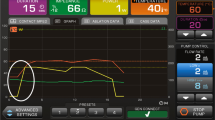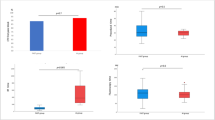Abstract
Purpose
Radiofrequency (RF) catheter ablation is widely accepted as a first-line therapy for cavotricuspid isthmus (CTI)-dependent atrial flutter (AFL). The novel DiamondTemp (DT) catheter with temperature feedback during RF ablation has been released recently on the market. The purpose of this study was to evaluate the impact of DiamondTemp (DT) technology on ablation efficiency during AFL.
Methods
In this single-center study, 30 consecutive patients with typical AFL indicated to ablation of CTI were included. The first 15 patients underwent CTI ablation using 8-mm tip catheter, and the following 15 patients underwent temperature-controlled RF ablation using DT catheter. The endpoints were number and mean total duration of RF applications, mean temperature reached in the setting of CTI, procedural times, and fluoroscopy times.
Results
There were no significant differences between the two groups concerning baseline characteristics. Mean duration of the each application (71.5 s ± 30.6 vs 12.4 s ± 13.2, p value < 0.001), mean total duration of RF applications (517,73 s ± 377,96 vs 112,8 s ± 43,58; p value < 0.001), procedural times (51.6 min ± 24.2 vs 38.6 ± 8.2; p = 0.03), and fluoroscopy times (16.2 min ± 10.2 vs 8 min ± 4.24; p = 0.005) were longer in the 8-mm ablation catheter group. Mean temperature measurements (51.9 °C ± 3.59 vs 56.7 °C ± 3.34, p value < 0.003) were as well lower in the 8-mm ablation catheter group.
Conclusions
Catheter ablation of CTI-dependent AFL by means of DT resulted in a significant reduction of total and single application RF delivery time, procedure, and fluoroscopy times.


Similar content being viewed by others
Data availability
Not applicable
Code availability
Not applicable
References
Pérez FJ, Schubert CM, Parvez B, Pathak V, Ellenbogen KA, Wood MA. Long-term outcomes after catheter ablation of cavo-tricuspid isthmus dependent atrial flutter: a meta-analysis. Circ Arrhythmia Electrophysiol. 2009; https://doi.org/10.1161/CIRCEP.109.871665.
Jaïs P, Haïssaguerre M, Shah DC, Takahashi A, Hocini M, Lavergne T, et al. Successful irrigated-tip catheter ablation of atrial flutter resistant to conventional radiofrequency ablation. Circulation. 1998; https://doi.org/10.1161/01.CIR.98.9.835.
Tsai CF, Tai CT, Yu WC, Chen YJ, Hsieh MH, Chiang CE, et al. Is 8-mm more effective than 4-mm tip electrode catheter for ablation of typical atrial flutter? Circulation. 1999; https://doi.org/10.1161/01.CIR.100.7.768.
Ventura R, Willems S, Weiss C, Flecke J, Risius T, Rostock T, et al. Large tip electrodes for successful elimination of atrial flutter resistant to conventional catheter ablation. J Interv Card Electrophysiol. 2003; https://doi.org/10.1023/A:1023665002255.
Jaïs P, Shah DC, Haïssaguerre M, Hocini M, Garrigue S, Le Metayer P, et al. Prospective randomized comparison of irrigated-tip versus conventional- tip catheters for ablation of common flutter. Circulation. 2000; https://doi.org/10.1161/01.CIR.101.7.772.
Natale A, Newby KH, Pisanó E, Leonelli F, Fanelli R, Potenza D, et al. Prospective randomized comparison of antiarrhythmic therapy versus first- line radiofrequency ablation in patients with atrial flutter. J Am Coll Cardiol. 2000; https://doi.org/10.1016/S0735-1097(00)00635-5.
Cuesta A, Mont L, Alvarenga N, Rogel U, Brugada J. Comparison of 8-mm-tip and irrigated-tip catheters in the ablation of isthmus-dependent atrial flutter: a prospective randomized trial. Rev Española Cardiol (English Ed. 2009; https://doi.org/10.1016/S1885-5857(09)72355-2.
Barman S, Srivastava GP. Temperature dependence of the thermal conductivity of different forms of diamond. J Appl Phys. 2007;101(12):123507. https://doi.org/10.1063/1.2747540.
Graebner JE, Jin S, Kammlott GW, Bacon B, Seibles L, Banholzer W. Anisotropic thermal conductivity in chemical vapor deposition diamond. J Appl Phys. 1992;71(11):5353–6. https://doi.org/10.1063/1.350553.
Graebner JE, Jin S, Herb JA, Gardinier CF. Local thermal conductivity in chemical-vapor-deposited diamond. J Appl Phys. 1994;76(3):1552–6. https://doi.org/10.1063/1.357733.
Scheuring A, Probst P, Stockhausen A, Ilin K, Siegel M, Scherer TA, Meier A, Strauss D. Dielectric RF Properties of CVD diamond disks from sub-mm wave to the frequencies. 35th International Conference on Infrared, Millimeter, and Terahertz Waves. 2010. https://doi.org/10.1109/icimw.2010.5612543
Kasugai A, Sakamoto K, Takahashi K, Tsuneoka M, Kariya T, Imai T, Braz O, Thumm M, Brandon JR, Sussman RS, Beale A, Ballington DC. Chemical vapor deposition diamond window for high-power and long pulse millimeter wave transmission. Rev Sci Instrum. 1998;69(5):2160–5. https://doi.org/10.1063/1.1148916.
Kautzner J, Albenque J-P, Natale A, Maddox W, Cuoco F, Neuzil P, Poty H, Getman MK, Liu S, Starek Z, Dukkipati SR, Colley BJ, Al-Ahmad A, Sidne DS, McElderry HT. A novel temperature-controlled radiofrequency catheter ablation system used to treat patients with paroxysmal atrial fibrillation. JACC Clin Electrophysiol. 2021;7(3):352–63. https://doi.org/10.1016/j.jacep.2020.11.009.
Brugada J, Katritsis DG, Arbelo E, Arribas F, Bax JJ, Blomström-Lundqvist C, et al. 2019 ESC Guidelines for the management of patients with supraventricular tachycardia The Task Force for the management of patients with supraventricular tachycardia of the European Society of Cardiology (ESC). Eur Heart J. 2019; https://doi.org/10.1093/eurheartj/ehz467.
Cauchemez B, Haissaguerre M, Fischer B, Thomas O, Clementy J, Coumel P. Electrophysiological effects of catheter ablation of inferior vena cava-tricuspid annulus isthmus in common atrial flutter. Circulation. 1996; https://doi.org/10.1161/01.CIR.93.2.284.
Ariyarathna N, Kumar S, Thomas SP, Stevenson WG, Michaud GF. Role of contact force sensing in catheter ablation of cardiac arrhythmias: evolution or history repeating itself? JACC: Clin Electrophysiol. 2018. https://doi.org/10.1016/j.jacep.2018.03.014.
Wolf M, El Haddad M, Fedida J, Taghji P, Van Beeumen K, Strisciuglio T, et al. Evaluation of left atrial linear ablation using contiguous and optimized radiofrequency lesions: the ALINE study. Europace. 2018; https://doi.org/10.1093/europace/eux350.
Sasaki T, Nakamura K, Inoue M, Minami K, Miki Y, Goto K, et al. Optimal local impedance drops for an effective radiofrequency ablation during cavo-tricuspid isthmus ablation. J Arrhythmia. 2020; https://doi.org/10.1002/joa3.12403.
Bourier F, Vlachos K, Frontera A, Martin CA, Lam A, Takigawa M, et al. In silico analysis of the relation between conventional and high-power short-duration RF ablation settings and resulting lesion metrics. J Cardiovasc Electrophysiol. 2020; https://doi.org/10.1111/jce.14495.
Iwasawa J, Koruth JS, Petru J, Dujka L, Kralovec S, Mzourkova K, et al. Temperature-controlled radiofrequency ablation for pulmonary vein isolation in patients with atrial fibrillation. J Am Coll Cardiol. 2017; https://doi.org/10.1016/j.jacc.2017.06.008.
Venier S, Andrade J, Dubuc M, Dyrda K, Guerra P, Khairy P, et al. Contact force-guided versus contact force-blinded catheter ablation of typical atrial flutter: a prospective study. Can J Cardiol. 2015; https://doi.org/10.1093/europace/euw137.
Sulkin MS, Laughner JI, Hilbert S, Kapa S, Kosiuk J, Younan P, et al. Novel measure of local impedance predicts catheter-tissue contact and lesion formation. Circ Arrhythm Electrophysiol. 2018; https://doi.org/10.1161/CIRCEP.117.005831.
Takehito Sasaki, Kohki Nakamura, Mitsuho Inoue, Kentaro Minami, Yuko Miki, Koji Goto,Yutaka Take, Kenichi Kaseno, Eiji Yamashita, Keiko Koyama, Shigeto Naito, Optimal local impedance drops for an effective radiofrequency ablation during cavo-tricuspid isthmus ablation. J Arrhythmia. 2020; https://doi.org/10.1002/joa3.12403.
Lewalter T, Weiss C, Spencker S, Jung W, Haverkamp W, Willems S, et al. Gold vs. platinumiridium tip catheter for cavotricuspid isthmus ablation: The AURUM 8 study. Europace. 2011; ablation: The AURUM 8 study. Europace. 2011; https://doi.org/10.1093/europace/euq339.
Lickfett L, Mittmann-Braun E, Weiss C, Spencker S, Jung W, Haverkamp W, et al. Differences in clinical and echocardiographic parameters between paroxysmal and persistent atrial flutter in the AURUM 8 study: targets for prevention of persistent arrhythmia? PACE - Pacing Clin Electrophysiol. 2013; https://doi.org/10.1111/pace.12051.
Kumar S, Romero J, Stevenson WG, Foley L, Caulfield R, Fujii A, et al. Impact of lowering irrigation flow rate on atrial lesion formation in thin atrial tissue: preliminary observations from experimental and clinical studies. JACC Clin Electrophysiol. 2017; https://doi.org/10.1016/j.jacep.2017.09.001.
Author information
Authors and Affiliations
Corresponding author
Ethics declarations
Ethics approval
The study protocol was carried out in accordance with the ethical principles of medical research involving human subjects established by the Declaration of Helsinki and was approved by the local ethics committee of our Institution.
Conflict of interest
CdA receive compensation on behalf of the center from Biotronik, Abbott, Boston Scientific, Biosense Webster, Microport, and Acutus Medical. CdA received compensation for teaching purposes and proctoring from AF solutions, Medtronic, Biotronik, AtriCure, Daiichi Sankyo, Abbott, Boston Scientific, Biosense Webster, and Acutus Medical. GB received compensation for teaching purposes and proctoring from AF solutions, Medtronic, Biotronik, Abbott, Boston Scientific, Biosense Webster, and Acutus Medical. PB receives research grants Biotronik.
Additional information
Publisher's note
Springer Nature remains neutral with regard to jurisdictional claims in published maps and institutional affiliations.
RR and FL contributed equally to the article as first authors. CdA and GB contributed equally to the article as senior authors.
Rights and permissions
About this article
Cite this article
Ramak, R., Lipartiti, F., Mojica, J. et al. Comparison between the novel diamond temp and the classical 8-mm tip ablation catheters in the setting of typical atrial flutter. J Interv Card Electrophysiol 64, 751–757 (2022). https://doi.org/10.1007/s10840-022-01152-w
Received:
Accepted:
Published:
Issue Date:
DOI: https://doi.org/10.1007/s10840-022-01152-w




